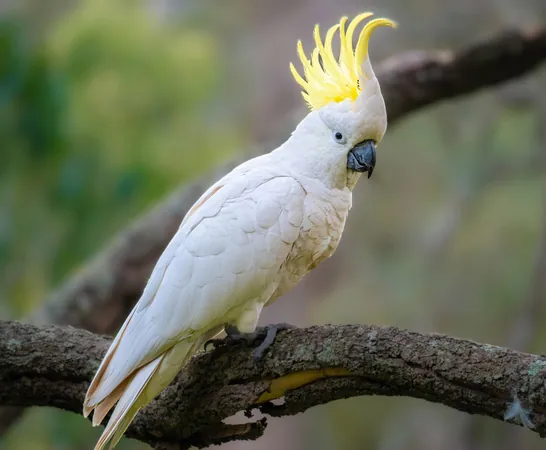
Revolutionary Genetic Discoveries Ignite New Hope for Cockatoo Conservation
2025-01-14
Author: Nur
Cockatoo Conservation Challenges
Cockatoos, with their vibrant plumage and striking personalities, have long been cherished symbols of the natural world. But what if everything we thought we knew about them was built on misconceptions? Recent research suggests that the differences among these magnificent birds go deeper than just their dazzling appearances—they reach down to their very DNA.
This groundbreaking perspective is reshaping how we approach cockatoo conservation. At the forefront of this movement are scientists from The University of Hong Kong, who are making significant advancements in protecting two species: the sulphur-crested cockatoo and the critically endangered yellow-crested cockatoo.
With a mere 2,000 yellow-crested cockatoos left in the wild, their survival is precariously threatened by habitat destruction, illegal poaching, and rapidly shifting environmental conditions. Once misjudged, these birds are now the subject of innovative genetic research that holds the promise of redefining their futures and catalyzing more precise conservation strategies for parrots across the globe.
Genetics: The Key to Future Conservation
Utilizing advanced genomic analysis, researchers are gaining crucial insights into the genetic makeup of these birds, leading to smarter conservation tactics. This cutting-edge technology doesn’t just enhance our understanding; it also encourages policymakers to revise regulations to better align with contemporary scientific findings. This pivotal shift could result in more effective strategies—not just for cockatoos, but for parrot species worldwide, helping to curb biodiversity loss.
Unearthing the Triton Cockatoo's Identity
In a striking revelation, the research has confirmed the Triton cockatoo as a distinct species, dispelling a century of confusion. Both the Triton and sulphur-crested cockatoos had previously been mistaken for one another due to their similar appearances and overlapping habitats in Australia and New Guinea. The new findings clarify that the Triton cockatoo is primarily found in central and western New Guinea, while its sulphur-crested relative occupies various regions in Australia and southern New Guinea.
Dr. Arthur Sands, the principal investigator of the study, emphasized the importance of maintaining genetic integrity: “Introducing the wrong species to a new habitat could wreak havoc, leading to hybridization or competition that could threaten their survival and disrupt ecosystems.”
Tracing Diversity through Museomics
The spotlight also turned to the alarming plight of the yellow-crested cockatoo. Researchers innovatively employed an approach called “museomics,” extracting DNA from century-old museum specimens to reveal the genetic diversity among three distinct groups within this species across the Wallacean region.
This method allows scientists to collect critical genetic information while minimizing disturbance to endangered populations—an essential factor in conservation efforts. Dr. Astrid Andersson, leading the yellow-crested cockatoo research, highlighted the importance of these findings: “Our study provides invaluable insights for conservation practices, including translocations and genetic rescue efforts, which are crucial for preventing the extinction of C. sulphurea.”
A New Era for Cockatoo Conservation
At the core of these pioneering studies lies a fundamental truth: recognizing the unique genetic identities of each cockatoo species is essential for their survival. Professor Juha Merilä, a co-author of the research, stated, “Identifying evolutionarily significant units is crucial for managing and conserving rare and threatened species. Our findings showcase the incredible genetic diversity within and between these iconic birds and stress the necessity of incorporating genetic data into conservation strategies.”
As we navigate the complexities of the 21st century, adopting this nuanced approach to conservation may prove to be our best strategy for preserving not just cockatoos but the rich tapestry of life on our planet. Without careful genetic assessment, misguided conservation initiatives could have devastating effects, warn researchers.
The full study detailing these groundbreaking discoveries has been published in the prestigious journal *Molecular Biology and Evolution*. The future of cockatoo conservation now rests on the intersection of genetic research and informed policy—an exciting endeavor that could ensure the survival of these charismatic birds for generations to come.
Stay updated on this fascinating journey of avian conservation and more—subscribe to our newsletter for the latest insights and revelations in wildlife preservation!

 Brasil (PT)
Brasil (PT)
 Canada (EN)
Canada (EN)
 Chile (ES)
Chile (ES)
 Česko (CS)
Česko (CS)
 대한민국 (KO)
대한민국 (KO)
 España (ES)
España (ES)
 France (FR)
France (FR)
 Hong Kong (EN)
Hong Kong (EN)
 Italia (IT)
Italia (IT)
 日本 (JA)
日本 (JA)
 Magyarország (HU)
Magyarország (HU)
 Norge (NO)
Norge (NO)
 Polska (PL)
Polska (PL)
 Schweiz (DE)
Schweiz (DE)
 Singapore (EN)
Singapore (EN)
 Sverige (SV)
Sverige (SV)
 Suomi (FI)
Suomi (FI)
 Türkiye (TR)
Türkiye (TR)
 الإمارات العربية المتحدة (AR)
الإمارات العربية المتحدة (AR)